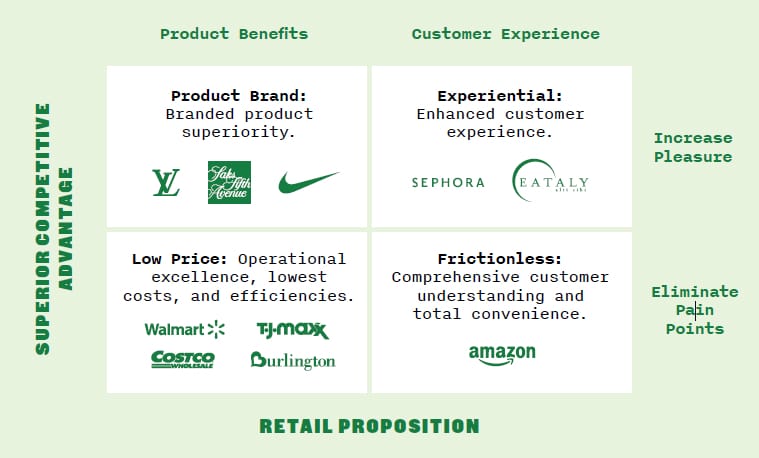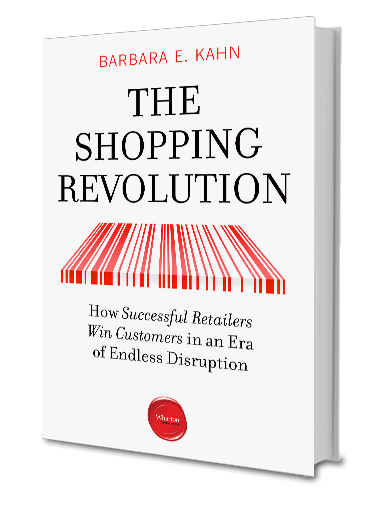How did Amazon become the retailer of choice for a large portion of the U.S. population? How did Walmart beat out other grocers in the late 1990s to become the leader in food retailing? How did Warby Parker make a dent in Luxottica’s lucrative eyewear business? How did Sephora draw customers away from the department stores and into its stores for beauty products? The answer in each of these cases is that retailers raised customers’ expectations on a key dimension of value: Amazon zeroed in on convenience, Walmart focused on low cost, Warby Parker offered hip branded eyewear to millennials, and Sephora provided a superior in-store customer experience. Each, then, became the market leader to targeted segments of customers by offering them value better than any competitor. But in retail, keeping this leadership position in only one aspect of customer value is not sufficient. Each of these retailers also leveraged its inherent advantage on its leadership value dimension to offer excellence on a second dimension. Today, Amazon not only offers convenience in shopping; it also guarantees very low prices. Walmart purchased Jet.com to augment its lowest price platform by also providing online convenience. Warby eliminated the middleman to offer glasses directly to the end user and thus was able to provide significant cost savings. Sephora built a huge loyalty program that merged its in-store and online experiences to build a personalized, convenient experience for each customer. What can the approach of these successful companies teach us about how to win customers in an era of endless disruption?
Mapping Successful Retail Strategies
Ironically, most classic frameworks that attempt to explain retail are missing a critical dimension: the customer perspective. When customers go shopping, what is it they want? What is the retail proposition? Customers want to buy something they value (product benefits) from someone they trust (customer experience). Whether customers buy it offline or online is a function of where they are, who they are with, and how much time they have.
The second dimension that most classic frameworks of retail are missing is that customers have lots of choices, and they gravitate to the retailers who offer them the best value on the dimensions they care about. In other words, retailers have to provide some kind of superior competitive advantage to what is offered by the competition. This superior value can be delivered either by providing more pleasure and benefits or by removing more pain and inconvenience. The Kahn Retailing Success Matrix offers a method for categorizing the most successful retailing strategies today, and it also offers a tool for organizations to use in plotting their own strategies.

Kahn Retailing Success Matrix
“The Retail Proposition,” the horizontal axis of this 2×2 matrix, represents the first principle: Customers want to buy something they want (product benefits) from someone they trust (customer experience). “Superior Competitive Advantage,” the vertical axis, represents the second principle: In order to win customers, retailers must offer products and experiences that are better than the competition. Here’s a closer look at each of the four strategies: Lead on Brand: Offer Branded Product Superiority. Retailers in the top left quadrant offer branded products that provide more differentiation, more value, and more pleasure and ultimately provide more confidence to a particular customer segment compared to other products on the market. Good examples include Nordstrom, Saks Fifth Avenue, Best Buy, and Kroger, which all carry nationally well-known and well-respected brands. Lead on Experiential: Offer Enhanced Customer Experience. Retailers in the top right quadrant offer a physical store customer experience that provides more pleasure, more excitement, and more fun than other retailers can provide. Eataly, Whole Foods, Story, Build-a-Bear Workshop, and Sephora fit this category. Here, the customer journey is seen as a lifestyle choice, not a chore. This is a high-touch, social experience. Lead on Low Price: Offer Operational Excellence and Lowest Cost Efficiencies. Providing reliable products or services at the lowest prices and therefore offering customers the best savings is the priority. Retailers in the lower left quadrant consistently offer the lowest prices and have developed operating models that can efficiently manage inventory, keep overhead costs down, eliminate unnecessary intermediary steps, and reduce transaction costs at every step. Think Walmart, Costco, TJ Maxx, and Burlington. Lead on Frictionless: Offer Comprehensive Customer Understanding and Total Convenience. These retailers provide a frictionless customer experience that eliminates all pain points and offers the customer the easiest and most convenient way to shop. The key deliverable in the lower right quadrant is a seamless integration of the shopping experience across all touchpoints. This requires the collection, capture, and analysis of all customer data. Constantly analyzing the data allows for customization and personalization as well. The best example here is Amazon—first through its online platform and subsequently with its integration of physical store pickups, lockers, and its own stores, and eventually incorporating data from its Amazon Echo platform.
Ever-Changing Customer Expectations
To survive, retailers have to aim to be at least at fair value in all of the quadrants. But to be a market leader, and thus the retailer of choice for specific customer segments, retailers must provide superior value (above fair value)—must literally be the best, if possible—in at least one quadrant (and, more often, be the best in two of the quadrants). As each retailer strives to win and offers something of value to the customer, over time this advantage becomes the new fair value, the new expected requirement to compete effectively. For example, when one retailer starts offering two-day delivery—or even same-day delivery—the expectations as to what constitutes fair value in delivery timing ratchet up. Thus, as industries become more competitive, customers’ expectations move further and further out to the corners of the grid, and it becomes harder to compete. Amazon has raised customers’ expectations as to what should be expected from a frictionless shopping experience. Sephora has proven that customers want to interact with and sample its beauty products and are no longer content to wait for a sales associate to pull the product out from behind the counter. Therefore, to be competitive in the market, retailers have to constantly keep track of customer expectations and make sure they are at least delivering value up to what is needed. This is forever challenging, because customers’ expectations are constantly increasing as competitors strive to become the market leader.
Barbara E. Kahn is the Patty and Jay H. Baker professor of marketing. Click here to purchase The Shopping Revolution: How Successful Retailers Win Customers in an Era of Endless Disruption.
Published as “Don’t Follow the Leader—Be the Leader’” in the Spring/Summer 2018 issue of Wharton Magazine.

























